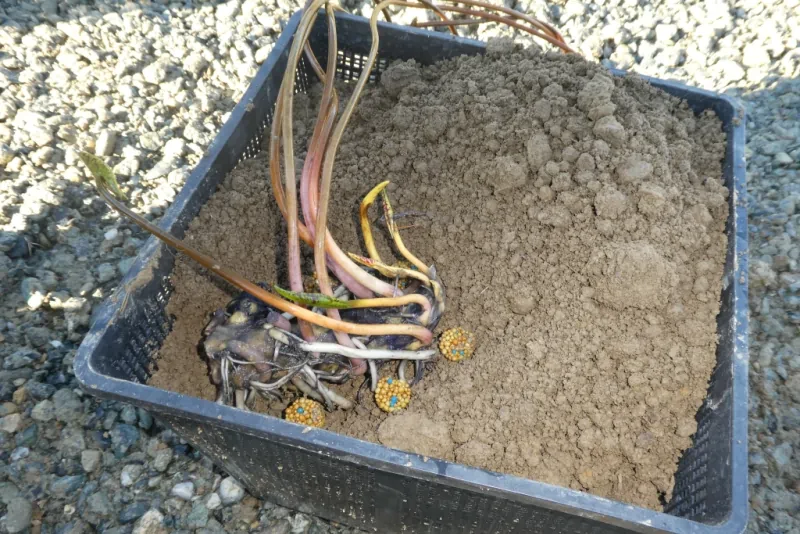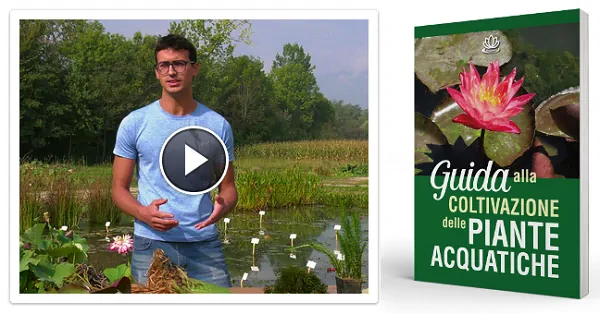
In this article we take a look at how to grow water lilies in a pond.
Water lilies should be planted in the deepest part of the pond, and can tolerate a depth ranging from a minimum of 30 cm to 1 meter.
In general, the optimal depth for growing water lilies is between 50 and 80 cm. Some very vigorous water lily varieties can also tolerate depths of up to 1.5 m.
Water lilies must be grown in full sun for good vegetation and abundant flowering.
Baskets for water lilies
To grow water lilies, I suggest that you use fairly large baskets, because over time they expand a lot.
The larger the baskets, the bigger and more vigorous the plant becomes. The deeper the basket is placed, the more the plant grows.
For example, if you put a large-sized water lily in a 20 cm diameter (or side) basket at a depth of 15 cm only between the soil and the water surface, the water lily will grow very little.
If, on the other hand, you put this water lily in a 50 cm diameter basket at a depth of 80 cm, it will grow quite large, covering an area of 1.5 square meters.
The soil to use for water lilies is common field soil, well loosened so as to avoid lumps. Avoid using peat, compost or other light soils, as these would float out of the basket, fouling the water.
The optimal baskets for water lilies are micro-perforated baskets with 1-3 mm holes, and for depths of 60-80 cm you should use baskets measuring 35×35 h.26 cm.
These baskets are excellent if you have to limit the space of the baskets, as the roots of the water lilies will also be able to come out of the baskets, absorbing nutrients at the bottom of the pond.
The holes in this type of baskets are very small, so only the roots pass through and not the plant itself (rightly so)!
How to plant water lilies
Water lily rhizomes can be long (with a cut on one side) as shown in the photo here, or round without a particular direction.
In the case of an elongated rhizome with a vegetative tip and a cut, you should place the cut against one side of the basket, and leave the tip towards the centre of the basket so that it has plenty of room to grow.
In addition, the cut side can be positioned slightly downwards, so that the cut is deeper and the vegetative tip more prominent (the plant will only grow from the tip).
If the rhizome does not have this shape, you can plant it normally in the centre of the basket.
The roots of the rhizome can be cut off, as the rhizome is always able to quickly produce new roots.
For a lush growth, I recommend that you put Osmocote Tablet fertiliser near the rhizome in quantities of 3 to 5 tablets, depending on the size and depth of planting.
For example, a small water lily at a shallow depth needs less fertiliser than a large water lily at a greater depth.
Cover the rhizome, leave the vegetative tip to emerge, and compress the soil well so that the rhizome does not risk surfacing again.

Protecting water lilies from fish
If you have small koi carp in the pond, you can put a very thin layer of gravel (1 cm) on top of the soil to prevent the fish from digging up the rhizome, or however, from digging, fouling the water.
If you have large koi carp (over 30 cm), I recommend that you place stones on top of the soil, which you will then remove in the following months once the water lilies have grown a lot.
Here you can find all water lilies available for online sale.
You can find more detailed information on how to grow water lilies and obtain a balanced pond in the Guide to Growing Aquatic Plants and in this free Video Course!
This article is also available in Italiano – Deutsch – Français – Español
